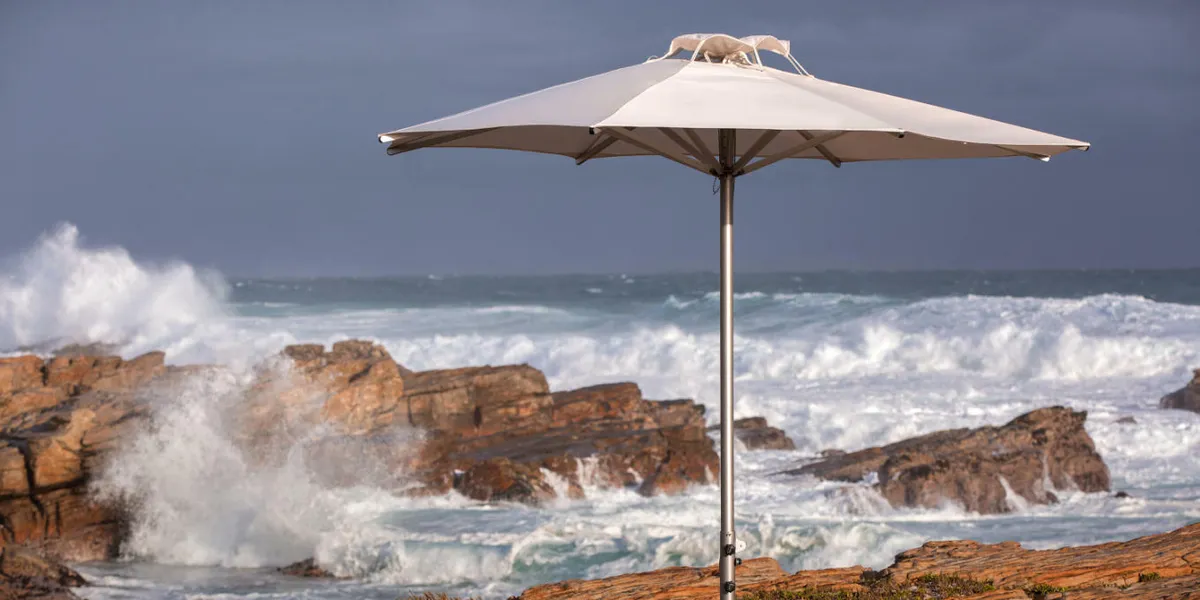Market Umbrellas

















Center pole umbrellas offer variety and portability
Market style umbrellas are identified by a straight support pole that runs through the middle of their canopy and most are used as standalone sunshades. However, their slender central pole can pass through the umbrella hole of specially designed dining tables to provide UV protection during al fresco meals. Market umbrella canopies are typically smaller than cantilevers, ranging between 6 to 15 feet in diameter, and may have decorative valances, scalloped or fringed edges. Some centerpost umbrellas have push button or crank tilt mechanisms that enable the shade to be maneuvered by simply angling and pivoting the canopy as the sun moves. Most of these parasols are stabilized by weighted umbrella stands, although larger versions can be permanently mounted on a concrete patio or hardwood deck. Some heavy freestanding bases are available with built-in wheels or casters for easier mobility.
Smart design for small spaces
While extra large cantilever umbrellas work well for spacious seating areas, they can be too big for smaller locations. Center pole umbrellas' small size and portability give them a lot of flexibility in how they can be used. Set one next to a wooden bench along a stone path to create a tranquil garden getaway. Or, slide one between a couple of sunloungers and you have a great pool umbrella. Live in a more urban area? These undersized sun shades are perfect protective cover for a balcony bistro set. Ideas for market umbrellas are abound.
Commercial quality market patio umbrellas from top brands
Decor Outdoor sells umbrellas from top-of-the-line manufacturers. Our featured designers produce sun shades for luxury resorts, high-end restaurants and upscale residential locations. >Our premium suppliers utilize strong aluminum, steel and hardwoods for center poles, ribs and hubs. Their top-of-the-line construction ensures the standalone patio umbrellas can stand up to the elements. Some have fiberglass ribs to improve performance in high winds.
Most are Sunbrella® umbrellas - the gold standard in high-performance outdoor textiles. Other brands of fabrics such as Outdura® are also durable but may have a shorter warranty against fading and ordinary use damage. These solution-dyed acrylic, polyester or olefin canopies are colorfast, repel water and are UV and tear-resistant. This durability is critical to ensure that sunshades function and look great for many seasons in various outdoor living settings. Marine-grade fabrics and finishes are suggested for yachts, beachfront property or homes where there is salt air.
Pro tips - Key center pole umbrella features to compare
- Lift Mechanism - Center pole umbrella canopies may raised and lowered by manually lifting the lower hub, using a crank, pulley and pin, etc.
- Tilt Mechanism - Some centerpost shades can be tilted by clicking a push-button, turning a crank or twisting a collar
- Wind Resistance - Check the Beaufort rating to determine how much wind an umbrella can handle safely
- Pole Type - Most poles are a single piece, but others come in two pieces and screw together and some telescope
- Pole Width - The wider an umbrella’s pole, the sturdier the shade but some may not fit through an umbrella table hole
- Rib Material - Centerpost umbrella ribs may be wood, metal or fiberglass, and each material reacts differently to the climate and wind
Frequently Asked Questions – Center pole umbrellas
Get answers to the questions our customers commonly ask about our market umbrellas and umbrella base options.
How heavy should an umbrella base be?
Center pole umbrella bases should be 10 pounds for every canopy foot if the shade is free-standing. For table-mounted umbrellas, the base should be 5 pounds per foot. So, to do some math:
- A 10 foot standalone centerpost umbrella should ideally have a 100 pound base.
- That same umbrella only needs 50 pounds if it's through a table.
Just remember: heavier is better. Without a proper weight for your umbrella stand, your parasol risks blowing over.
Are fiberglass ribs better for centerpost umbrellas than aluminum ones?
Fiberglass ribs tend to be more more wind-resistant and durable than aluminum ones. This is due to their flexibility, which enables them bend in strong winds rather than break. Lightweight and strong, fiberglass is also non-corrosive and can handle outdoor use in a variety of environments.
Aluminum ribs are also light, sturdy and rust-resistant, although they may require an anodized or powder-coated finish for best results. This alloy is less flexible and may break in high winds if the umbrella is left open (not advised). It also conducts heat and may be hot or cold to the touch in extreme temperatures.
Fiberglass ribs can be more expensive but if wind-resistance is your priority they're a great choice. Otherwise, aluminum ribs are perfectly able to handle less sever weather conditions at a lower price.
Are market umbrellas really round?
While many patio umbrella canopies are advertised as "round," most are actually octagonal or even hexagonal. However, there are some center pole umbrellas that are essentially round but they tend to be smaller. Square, rectangular patio umbrellas and even half canopies are also available.
No matter the shape, size, or flow of your space, there is a market patio umbrella to suit it.
